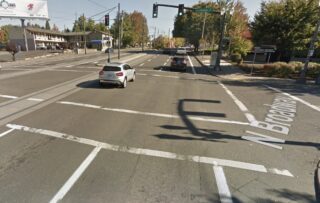
Despite confusion from some lawmakers that led to an unexpectedly lengthy discussion prior to the vote, House Bill 2682 passed the Joint Committee on Transportation yesterday by a tally of 7-3.
I’ve described this bill as a no-brainer; but because it involves bicycling, you just never know what some Oregon legislators will get hung up on. I was amazed at how much consternation and discussion this simple housekeeping bill received in committee yesterday.
“The attempt of this bill is to clarify longstanding practice and expectation.”
— Lindsay Baker, ODOT government relations
Let’s be clear: Since bike lanes have existed in Oregon, it has been understood — both by road users and the legal system — that they exist inside intersections even though they are not painted. Same for every other lane. Road authorities do not paint lane lines in intersections because with all the turning movements it would be a maintenance nightmare, dangerously confusing, and useless.
Out of hundreds, if not thousands, of court cases over the years, for some reason two Oregon traffic court judges — one in 2009, one in 2018 — took it upon themselves to decide that a bicycle user did not have the legal right-of-way in a collision because the lane wasn’t painted. Out of concern that these two outlier cases might start a trend, advocates proposed HB 2682. The text of the bill is short and simple.
If passed, HB 2682 would amend Oregon Revised Statute 801.155 (definition of “bicycle lane”) to read: “A bicycle lane exists in an intersection if the bicycle lane is marked on opposite sides of the intersection in the same direction of travel.”
Despite this simple clarification, three lawmakers voted against the bill yesterday: Representative Brad Witt (D-Clatskanie), Representative Lynn Findley (R-Vale), and Representative Rick Lewis (R-Silverton).
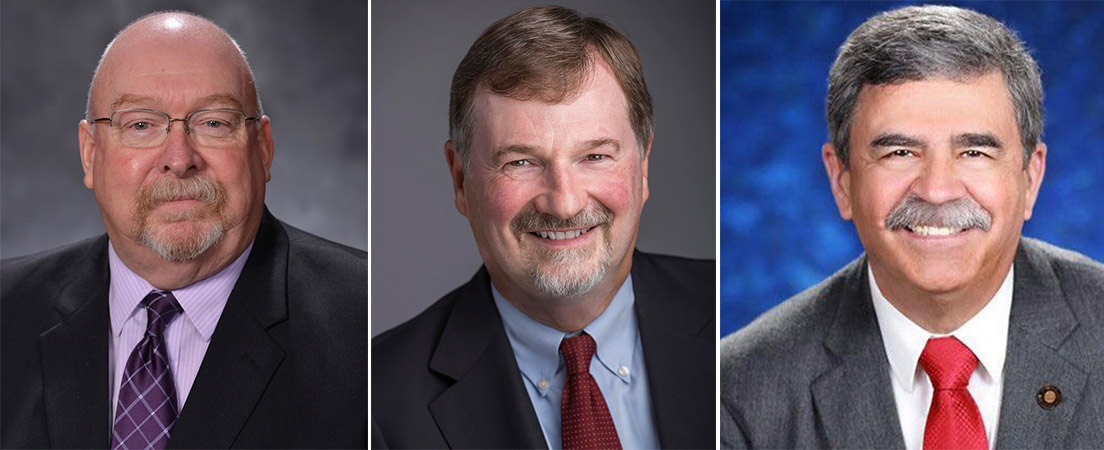
Rep. Witt based his opposition on what appears to be a misunderstanding of what the bill actually proposes. “I think we create an exceedingly dangerous situation,” he said, in a discussion prior to the roll being called, “by creating bicycle lanes that go through intersections” (that’s what existing law says). Rep. Witt continued, “It would be reasonable for someone to assume if they are in a marked lane they have a right-of-way. And lanes that are marked on the same side that a car may be turning, I think is a prescription for disaster… I think this bill sets us up for disastrous accidents if it allows for passing on the same side that the lane is in, and I think that bicyclists are going to assume that they have a lane and that it’s safe to be passing vehicles on the side the vehicle is turning on.”
Advertisement
Rep. Lewis said he agrees with Witt, but his main concern is that the bill doesn’t include, “Some sort of traffic signal adjacent to an intersection that indicates a bike lane goes through.” Lewis is concerned that automobile users aren’t able to see all the way to the other side of an intersection and therefore won’t assume the bike lane exists. “A motorist could potentially be found liable if he turns right and hits a bicyclist and didn’t know there was a continuous bike lane on the other side because of the distance,” Lewis said.
“A motorist could potentially be found liable if he turns right and hits a bicyclist and didn’t know there was a continuous bike lane on the other side.”
— Rep. Rick Lewis
Senator Cliff Bentz (D-Ontario) also voiced confusion about existing law and what the proposed bill would do. “The question is, who has the right-of-way as you’re zipping through? If we’re merely painting a line to illustrate the existence of something already legally there, that’s one thing. If by painting the line we are creating a new set of rights, that’s another.”
This bill doesn’t “paint” anything so it’s unclear what Sen. Bentz was referring to.
At this point, Committee Vice-Chair Caddy McKeown felt the need for expert insights and called up Lindsay Baker from the Oregon Department of Transportation government relations office. Baker explained why ODOT never paints lanes through intersections and that the bill is simply to, “Clarify longstanding practice and expectations.”
Unfortunately ODOT’s Baker got one key fact very wrong in her testimony to lawmakers. She said the two decisions where judges ruled unstriped bike lanes have no legal standing were made in the Oregon Court of Appeals and as such, they set a legal precedent. That is incorrect. The two cases were decided in traffic court and no opinion was written.
Thankfully, Portland lawyer and bike law expert Ray Thomas made the trip to Salem and was in the room yesterday just in case this hearing went off the rails. Vice-Chair McKeown called him up and asked him to clarify the bill. Thomas has practiced law with a focus on cycling and traffic issues since 1979. He deftly laid out the rationale behind the bill, countered some of the concerns expressed in previous statements, and explained why this basic clarification is necessary.
After Thomas spoke, the vote was held. The bill passed 7-3. Reps. Lewis and Witt were not swayed by Thomas’ expert insights and Rep. Findley, after saying he agreed with Rep. Witt’s concerns, added a revealing reference to an unrelated bill: “Also, there’s a lot of discussion of adopting the Idaho standard for bicycling; which is, do not stop at intersections, just roll through and keep going. I think coupled with that, it compounds the situation.”
Rep. Findley was referring to Senate Bill 998 which passed committee last week. That bill would allow bicycle users to treat stop signs and flashing red signals as yields. The only connection it has to HB 2682 exists in Rep. Findley’s mind.
From here the bill goes to the full House for a vote and then it will be voted on by the Senate. Be sure to contact your state legislator and let them know how you feel about it.
UPDATE: This bill eventually passed and was signed by the governor. It went into effect January 1, 2020.


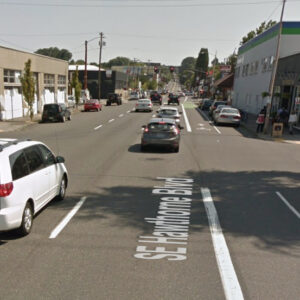
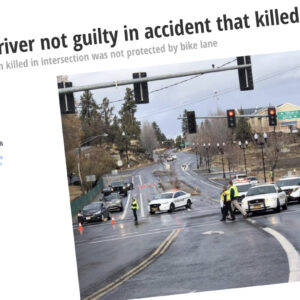

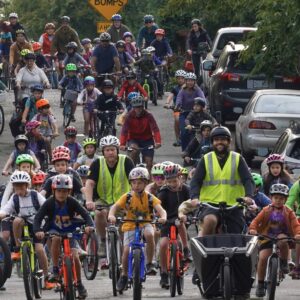
Thanks for reading.
BikePortland has served this community with independent community journalism since 2005. We rely on subscriptions from readers like you to survive. Your financial support is vital in keeping this valuable resource alive and well.
Please subscribe today to strengthen and expand our work.
Yesterday’s work session provides a window into what The Street Trust experienced in our efforts to get a hearing on this bill and then get it to a Joint Transportation Committee work session. The opponents are very vocal and many proponents are less so. It could have easily died in committee. We are thrilled we were able to get it out of the committee with a thoughtful strategy, great support from folks like Ray and Bend attorney Peter Werner, and behind-the-scenes lobbying. Now it’s on to the House and Senate.
Call or email your representatives today to ask them to support HB 2682 as it comes to a floor vote in the House and Senate!
Find out who your State Representative and State Senator is at https://www.oregonlegislature.gov/FindYourLegislator/leg-districts-mobile_new.htm
Call and/or email them with a short message about why you support clarification that bike lanes continue through intersections.
And beyond passing this bill, The Street Trust will continue its efforts identify and educate elected leaders who make these transportation decisions.
Clatskanie, Vale, and Silverton. Is it any wonder that they don’t seem to understand how bike lanes work? Their statements make it apparent that they have either never seen one, or haven’t been paying attention.
Regardless of what’s going on in their hometowns, there are bike lanes wihtin a few hundred feet of the Capitol. It’s rather concerning our lawmakers don’t understand how they work and their legal responsibilities with respect to roads they presumably frequent.
As to representatives in “Clatskanie, Vale, and Silverton” never* seeing a bike lane…perhaps that is why cycling advocates need to set up an alliance with farmers / farming community about jointing protecting their communities’ vulnerable roadway users: the farmer on a “tractor” (farm equipment travelling between fields).
*I hope these legislators from rural areas actually have seen a bike lane…as they do spend about 3 months during session in the “big city” of Salem that has bike lanes AND bicyclists.
Rep. Witt said: “And lanes that are marked on the same side that a car may be turning, I think is a prescription for disaster… I think this bill sets us up for disastrous accidents if it allows for passing on the same side that the lane is in, and I think that bicyclists are going to assume that they have a lane and that it’s safe to be passing vehicles on the side the vehicle is turning on.”
In other words, don’t put a going-straight lane to the right of a turning-right lane. I have to agree with him on that (even though I think the notion that bike lanes disappear at an intersection is lunacy, and that this bill is a slam-dunk).
In the Netherlands, the bike lane is always on the right of the turning lane as it crosses the intersection, and motorists have become used to that setup. Also, motorists need to look out for pedestrians crossing, so the idea that drivers need to look out for traffic on the right as they are turning right is not a new concept even in the United States.
One would think that in most circumstances a motorist turning right at an intersection would be found liable for hitting a bicyclist? Or am I missing something that Rep. Lewis sees?
Legally a bicyclist in a bike lane would expect to move forward through an intersection when the light turns green.
In reality we all know that right hooks are an issue, and you never know who will be turning right, and whether they will yield. That’s why the separate bike signals are so valuable. We just need a few thousand more of those perhaps.
By the statement “The question is, who has the right-of-way as you’re zipping through? “, it seems as though these people view entering an intersection and continuing straight is somehow a crazy maneuver that “bikes” are pulling and poor automobile drivers have no way to account for it. So yes, I’d say you’re missing something – the fact that if these people are so mixed up that they think that not paying attention because you’re in a metal box should be protected by law.
I’ve often had this thought, but pedestrians also go straight when people are turning right at crosswalks. Which then led me to the thought of, “Well, people driving cars should be hyper vigilant and always ready to stop for an active road user.”
Pedestrians rarely approach a driver in their blind spot, at speed. They move more slowly, and are visible for the entire time there is a risk of collision. I’m not saying cyclists are at fault for right-hooks, only that they differ from pedestrians in some important ways that makes accidental collisions with cars more likely given the way our intersections are designed.
This statement would be true if motor vehicles didn’t have A-pillars, side mirrors, blocky/tall hoods, etc.
I started carrying my action cam with me to the corner store for that A pillar reason. I had one person claim, as a non-apologetic explanation for her actions, that she almost ran me down in the crosswalk because I was in her blind spot. Gee, I wonder whose job it is to look around that A pillar.
The light changes and you get 3 seconds (locations may vary) to step into the crosswalk before the countdown starts. It’s not like you have a choice as a pedestrian about when to enter the crosswalk. That tiny window of when you are legally permitted to step into the roadway is the thing that puts you into conflict with left turning motorists who can’t be bothered to look where their car is going.
The fact remains that statements along the lines of “they came out of nowhere” are just doublespeak for “I wasn’t paying adequate attention before executing a maneuver”.
This is absolutely sometimes true.
Yet somehow thousands of pedestrians are killed crossing with the light in a crosswalk by a vehicle turning through the crosswalk in both directions. Left turns especially vex me because the driver has a clear view of the crosswalk through the windshield, and they still kill hundreds of pedestrians that way every year.
Well sorry that you guys might think that, but literally EVERY bike lane in the United States is on the right. Bar none.
Tilting at windmills much? *exasperated*
Like this one?
https://www.google.com/maps/@45.514625,-122.6762769,3a,75y,105.75h,67.22t/data=!3m6!1e1!3m4!1s09HSK_9w_XlXVBloYPIJmg!2e0!7i13312!8i6656
Please remember to be SUPER polite if you contact them, or maybe don’t at all? We don’t want another repeat where the Idaho Stop Law gets killed because we piss of the legislators by communicating like jerks.
Thanks to state rep Rob Nosse (and Schouten) for sponsoring the bill. Rob brought this up after a constituent who likely reads this blog brought the 2 previous court cases to his attention. Talking to your elected reps works. We don’t always get what we want, but we do have politicians for a reason.
I definitely appreciate Rep. Nosse meeting with me to discuss the issue! It’s not every day that you get to draw pictures of intersections on napkins and discuss traffic laws over a Saturday morning coffee with your elected representative.
Kudos to BikePortland as well for covering this issue! I’m a former right-hook victim myself and was disheartened to hear about two fellow Oregonians that weren’t protected by the law as it was intended.
Thank you Ted for taking action, contacting Rep Jose and testifying at the public hearing in March!
It’s disheartening to see that lawmakers are confused by this topic. It doesn’t inspire confidence their decisions on other topics in the legislature are any more informed.
Also the idea that we would have to paint lines through intersection for lanes to be considered “there” would lead to total confusion about how unmarked crosswalks work. The breaks in the lines through intersections is how the unmarked crosswalk is delineated. Without the line breaks neither pedestrians nor drivers would be certain where pedestrians are supposed to cross and who has to yield to the other.
If they thought about this for even a second in the context of right-turn slip lanes, left turn pocket lanes, etc, they would realize how dumb they sound. If lanes don’t continue through the intersection, people could do whatever they wanted once they enter. U-turn from the right lane? No problem. Use the left turn and/or right turn lanes to pass someone going straight? Go right ahead.
Yes true there should not have been this much confusion. (Not everyone should have to be a traffic engineer…BUT why has not ODoT staff done any education and outreach to the elected representatives on this…or be in attendance at this session…their main office is just down the road, correct? WHY does Ray Thomas have to be the one to do this very important task.?!)
Jonathan – your article needs correction/ clarifications: “Same for every other lane. Road authorities do not paint lane lines in intersections because with all the turning movements it would be a maintenance nightmare, dangerously confusing, and useless.”
1) road authorities do in fact mark some car lanes through an intersection with a dash if the intersection is very large or the turning track is complex;
2) bike lanes at the top of a “T” intersection are often striped through the intersection, as this is a best practice (Eugene has been doing it for over 20 years, etc.); and
3) NACTO and many cities do stripe bike lanes (typically green ‘bike crosswalks’ at conflict zones) through many intersections, see NACTO Urban Bikeway Design Guide chapter on Intersection Treatments.
https://nacto.org/publication/urban-bikeway-design-guide/intersection-treatments/intersection-crossing-markings/
To Continue:
Actually these marked intersection treatments can be useful and provide a safety enhancement; as with ALL roadway marking and signage there is a maintenance component…one just attempts to BALANCE the safety outcomes with the maintenance costs. [At least that was what I was taught at my time with public works.] Or else all streets would be “naked”. [Potentially someday once VZ is 100% completed.]
Furthermore, good and consistent striping [especially for vulnerable roadway users facilities: bike lanes and crosswalks] for now will have a greater need as AI and “intelligent” cars being unleashed on many public streets need supplemental “information” on how to navigate these shared multimodal spaces (vs. their mono-modal test tracks or suburban Arizona communities).
This is so idiotic.
If bike laws are being taken to these literal extremes, I have to ask whether bike retailers are helping people get around the bike tax by selling them a bike without the saddle.
“Oregon law defines a bicycle as a vehicle which is designed to be operated
on the ground on no more than three wheels. The wheels must measure
at least 14” in diameter. The vehicle must have a seat for the rider and be
propelled exclusively by human power. ”
https://www.oregon.gov/odot/programs/tdd%20documents/oregon-bicyclist-manual.pdf
Great idea!!! So, I guess trials mountain bikes would not qualify!
Personally, I have never kept the stock saddle on any of my bikes. I’ve got a tub full of nearly new saddles that are not very comfortable.
I understand that serving in the OR legislature isn’t likely to be anyone’s full-time job. However, if people who get elected can’t be bothered to take the time to understand the issue before them, they should either ask enough clarifying questions during the hearing to get that understanding or simply abstain from voting. These three make the entire legislature look unprofessional, ignorant and just plain awful.
The good news is our legislature is far from the worst in the nation in spite of these three gentlemen’s efforts. That’s also the bad news.
If one has followed Rep. Witt over the years, one realizes he’s more concerned about the people who are breaking the law speeding (and caught by “speed traps” and traffic cameras) than the safety of people on our roads. Looking forward to his retirement, whenever that may come.
He looks like the type who would have trouble getting anywhere without the help of a mobility device (fossil-fueled or otherwise).
What makes me sad is that regardless of your politics it is obvious that none of these gentlemen is the kind of “big picture thinker” we need in both state and national politics if we are to solve the impending crisis that face our species and our planet in the immediate future.
Spend a few days in Clatskanie. It will make more sense.
Here’s a note I’ve drafted to my rep and senator. I’d appreciate it if some of y’all would take a look and see if I’ve got the facts right (some of this stuff is actually from memory and I haven’t gone back to confirm. If it’s useful to anyone, feel free to use some of this info in your own words. Anything else I should add? Please help me make it better in any way.
Dear Rep. [fill in your rep’s name]: I’m writing to ask you to support two bills that are really important to me and other people who get around by bicycle here in Washington County. Both clarify existing common practice and/or law, and both are crucial to making non-car transportation a viable means of getting around town for work, errands, school, etc. They’re also therefore vital to Oregon achieving its announced goals on reducing carbon emissions to protect our planet, and to saving us millions of dollars in infrastructure construction and repair costs.
HB 2682 clarifies that bike lanes extend through intersections, rectifying a couple of wrong headed traffic court decisions that contradict the previous universal understanding that if you’re riding in a bike lane approaching an intersection, and the bike lane continues on the other side of the cross street, then the bike lane also continues exist in the intersection itself. I realize this is pretty obvious to almost everyone, including drivers like me and my wife, but apparently it needs to be codified so that everyone’s legal responsibilities can match our common sense understanding.
SB 998 again makes law conform to reality. The so called Idaho Stop law allows bicyclists to slow down at stop signs, carefully check for traffic or pedestrians coming from either direction, and then proceed without coming to a total stop. Again, this is what everyone does anyway, because maintaining momentum is really important to making a bike ride enjoyable rather than a total sweaty slog where you might have to stop and start up every few blocks, overcoming inertia (and in my case putting a strain on my tendinitis-plagued knees). A lot of people who might choose to bike for a short trip to the library or gym or grocery store (short trips like these are the majority of car trips today) are discouraged by several seemingly small but practically difficult obstacles, and this is a really big one, making the difference for people who aren’t in their 20s and in perfect physical condition.
It also removes a possible means of harassment of African American and other minority cyclists by law enforcement agencies, a problem of racially disproportionate enforcement that’s been cited by minority representatives in East Portland. I’ve done the slow and go move many times in front of police officers, who have never pulled me over — but they could. Legalizing the Idaho stop removes one possible means of disparate enforcement. Most bicyclists are, contrary to myth, lower than average income people, which makes sense because a bike is a lot cheaper than buying, fueling and maintaining a car, so this is important in low income and minority communities.
The experience of Idaho and other jurisdictions that have implemented this practice has shown no increase in collisions, and an uptick in people choosing to use bicycles, and therefore presumably driving less (and exercising more, which is good for everyone). After all, we bicyclists have the greatest incentive to proceed carefully through any intersection — our lives are at stake.
A lot of my friends and family members bicycle for fun and practicality, and we all support the Idaho stop. (I haven’t talked to them about the other bill because I think we all assumed that was already the law.) I’m sure literally thousands of car trips would be avoided if these bills become law. Voting for both these bills will allow us to reduce our use of cars and help save Oregon money, not to mention helping, in our own small way, to save all of us from the effects of climate change. Thanks for listening.
“I’m writing to ask you to support two bills that are really important to me and other people who get around by bicycle here in Washington County.”
I would drop the reference to bicycles in that first sentence and just leave it as “bills important to me and others as residents of Washington County.”
Hold off on identifying yourself as a bicyclist as long as possible if at all. That’s going to make lots of people with windshield bias stop reading.
If you want your rep to read it, my advice is make it half as long, and then make it half as long again.
Note that this comment started out four paragraphs long.
Maybe after passing this “bike-lanes-exist-in-intersections” legislation, the lawmakers can move on to important “bricks-are-heavy” and “the-sun-is-warm” legislation.
In my experience, a car traveling 25mph, seen aproaching 500 feet away from me, has no chance of seeing me. This is a golden rule that I rely on which has exclusively prevented me from ever being hit. Ramming some common sense through legislation is not going to make drivers less stupid. We need more enforcement. My neighbor was speeding drunk with a car full of kids, hit 2 people and 8 cars, charged with DUII, attempted manslaughter (he told police it was intentional because he was angry) and 5 counts felony reckless endangerment, 16 other charges… I personally talked to the district attorney, his sentence was an 80 dollar fine and recieving a brand new 32,000 dollar car. Bad drivers are encouraged and rewarded, it has to stop.
If I am correct, this stems from the death of a Bend cyclist. The truck driver who killed him, was found not guilty at trial, because the judge essentially said that bike lane protection ceased during intersections.
I’ve been watching this Committee for a while. I think Whitt has not been properly engaged. And he gets regularly ignored when he had a significant question (re:hearing on public transport from Hal Gard at TriMet. He gets it on some levels, maybe he is saying no to other things on the committee. Gentle nudges, do not insult. Kindness educates.
Wow, these legislators are dumb as bricks.
Wow. Misconceptions abound.
To address some of the concerns regarding the seemingly expected massive increase in right hooks, the legislature might also consider amending ORS 814.420 to change the wording in one of the exceptions:
Although the interpretation some of these lawmakers would like to take does allow any bicyclist to take a full lane through any intersection.
This story seems to be the source of unlimited facepalms. Maybe we could use them to power TriMet buses.
Judge Adler is a Deschutes County Circuit Court Judge and not a traffic court judge. His ruling was about the Fedex driver who killed a cyclist after a right hook.
Listening to these Representatives object to this bill gives me chills. Really stop and consider the implications. They accept that motorists are going too fast and not looking where they are going. *That* is a recipe for disaster.
“The question is, who has the right-of-way as you’re zipping through? ”
Lewis is concerned that automobile users aren’t able to see all the way to the other side of an intersection .